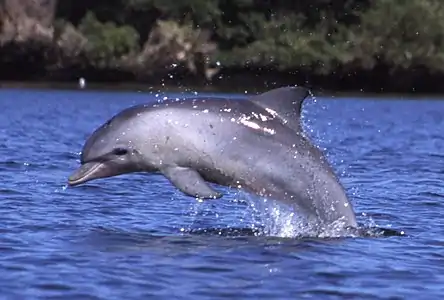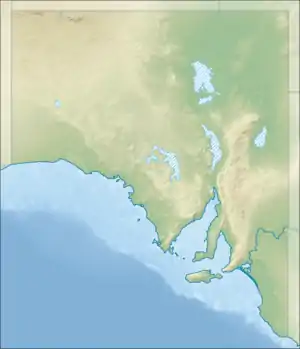Adelaide Dolphin Sanctuary
Adelaide Dolphin Sanctuary is a marine protected area in the Australian state of South Australia located on the east coast of Gulf St Vincent in and adjoining the north-western part of the Adelaide metropolitan area and which was established in 2005 for the protection of a resident population of Indo-Pacific bottlenose dolphins (Tursiops aduncus).[3]
| Adelaide Dolphin Sanctuary South Australia | |
|---|---|
IUCN category IV (habitat/species management area)[1] | |
 Dolphin in the Port River | |
 Adelaide Dolphin Sanctuary | |
| Nearest town or city | Port Adelaide |
| Coordinates | 34°44′35.15″S 138°29′23.64″E |
| Established | 4 June 2005[2] |
| Area | 118.75 km2 (45.8 sq mi)[1] |
| Managing authorities | Department for Environment and Water |
| Website | Adelaide Dolphin Sanctuary |
| See also | Protected areas of South Australia |
The sanctuary covers an area of coastline extending from Port Gawler in the north to North Haven in the south, and includes the waterways of the Port Adelaide River, the Barker Inlet and some associated channels, as well as Torrens and Garden Islands, and inlets on the Lefevre Peninsula such as Mutton Cove. The habitat protected by the sanctuary consists of “mangroves, seagrass, saltmarsh, tidal flats, tidal creeks and estuarine rivers.”[4] As of 2014, it covered an area of 118.75 square kilometres (45.85 sq mi).[1][3]
The sanctuary was proclaimed in 2005 for the purpose of achieving the following two objects:[2][5]
(a) to protect the dolphin population of the Port Adelaide River estuary and Barker Inlet; and
(b) to protect the natural habitat of that population.
The sanctuary is also required to achieve the following six objectives:[6]
(a) the protection of the dolphin population of the Port Adelaide River estuary and Barker Inlet from direct physical harm is to be maintained and improved;
(b) the key habitat features in the Port Adelaide River estuary and Barker Inlet that are necessary to sustain the dolphin population are to be maintained, protected and restored;
(c) water quality within the Port Adelaide River estuary and Barker Inlet should be improved to a level that sustains the ecological processes, environmental values and productive capacity of the Port Adelaide River estuary and Barker Inlet;
(d) the interests of the community are to be taken into account by recognising indigenous and other cultural, and historical, relationships with the Port Adelaide River estuary and Barker Inlet and surrounding areas, and by ensuring appropriate participation in processes associated with the management of the Port Adelaide River estuary and Barker Inlet;
(e) public awareness of the importance of a healthy Port Adelaide River estuary and Barker Inlet to the economic, social and cultural prosperities of the local communities, and the community more generally, is to be promoted;
(f) the principles of ecological sustainable development in relation to the use and management of the Port Adelaide River estuary and Barker Inlet are to be promoted.
As of June 2015, the Adelaide Dolphin Sanctuary was managed by the Department of Environment and Water with assistance from other South Australian government agencies, local government and other organizations with responsibilities in respect to the waters and land associated with the sanctuary or having an interest in such. Management activity was supported by a community volunteer group known as the ADS Action Group which was created in 2012 and which had 50 registered volunteers in 2015.[7][3]
The Adelaide Dolphin Sanctuary shares territory with the following protected areas – the Barker Inlet-St Kilda Aquatic Reserve, the Port Gawler Conservation Park, the majority of the St Kilda – Chapman Creek Aquatic Reserve and the Torrens Island Conservation Park. It will also share territory with parts of the Adelaide International Bird Sanctuary yet to be proclaimed as of 27 October 2016 and which are located in localities and suburbs including Bolivar, Buckland Park, Dry Creek, Globe Derby Park, Port Gawler and St Kilda.[4][8][9]
The sanctuary also adjoins the Adelaide Metropolitan Beaches Restricted Area which extends from North Haven in the north along the Adelaide metropolitan coastline to Sellicks Beach in the south and which is described in the National Parks and Wildlife (Protected Animals—Marine Mammals) Regulations 2010. Both the sanctuary and the Adelaide Metropolitan Beaches Restricted Area are areas subject to the additional regulatory requirements regarding “commercial activities” in respect to interaction with marine mammals including all species of dolphins present in South Australia.[10]
The sanctuary is classified as an IUCN Category VI protected area.[1]
References
- "Marine Protected Areas in coastal waters of South Australia (refer 'Detailed List' TAB)". CAPAD 2016. Australian government. Retrieved 15 January 2018.
- "Adelaide Dolphin Sanctuary Act (Commencement) Proclamation 2005" (PDF). The South Australian Government Gazette. Government of South Australia: 1684. 2 June 2005. Retrieved 2 May 2017.
- Adelaide Dolphin Sanctuary Management Plan (PDF). Government of South Australia , Department for Environment and Heritage (DEH). June 2008. pp. 2, 4, 7, 8–22 & 24. ISBN 1-92123-807-0.
- "Search result for Adelaide Dolphin Sanctuary with the following datasets selected – "Aquatic Reserves", "Dolphin Sanctuary", "NPW and Conservation Reserve Boundaries" and "Suburbs and Localities"". Location SA Map Viewer. Government of South Australia. Retrieved 2 May 2017.
- "Adelaide Dolphin Sanctuary Act 2005 – Sect 7". Government of South Australia. Retrieved 2 May 2017.
- "Adelaide Dolphin Sanctuary Act 2005 – Sect 8". Government of South Australia. Retrieved 2 May 2017.
- Adelaide Dolphin Sanctuary Act 2005, Annual Report, 1 July 2014 to 30 June 2015 (PDF). Government of South Australia. 2015. p. 12.
- "Saltfields, Creating the Adelaide International Bird Sanctuary" (PDF). The Government of South Australia, Department of Environment Water and Natural Resources (DEWNR). 1 September 2014. p. 19. Retrieved 5 December 2014.
- "National Parks and Wildlife (Adelaide International Bird Sanctuary National Park—Winaityinaityi Pangkara—Mining Rights) Proclamation 2016" (PDF). South Australian Government Gazette. Government of South Australia. pp. 4240–4243. Retrieved 28 October 2016.
- National Parks and Wildlife (Protected Animals—Marine Mammals) Regulations 2010 under the National Parks and Wildlife Act 1972 (PDF). Government of South Australia (GSA), Attorney-General's Department. 2014. pp. 2, 8 & 9. Archived from the original (PDF) on 17 January 2018. Retrieved 2 May 2017.
External links
- Official webpage
- The webpage for the Adelaide Dolphin Sanctuary on the Protected Planet website
- Port River Dolphins, Behind the News